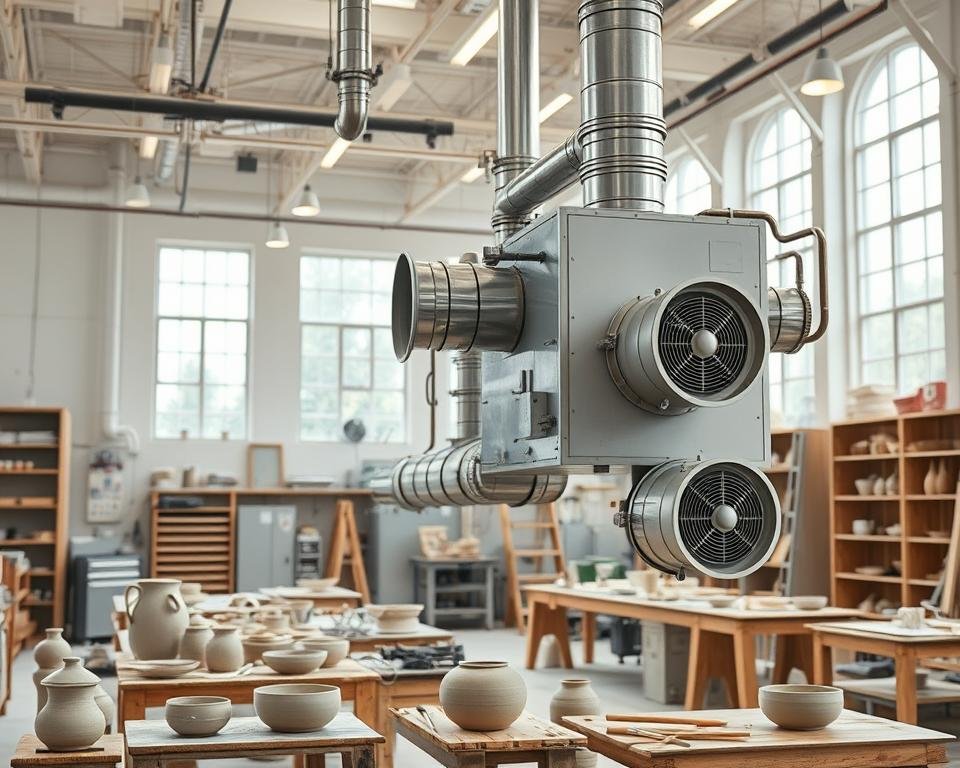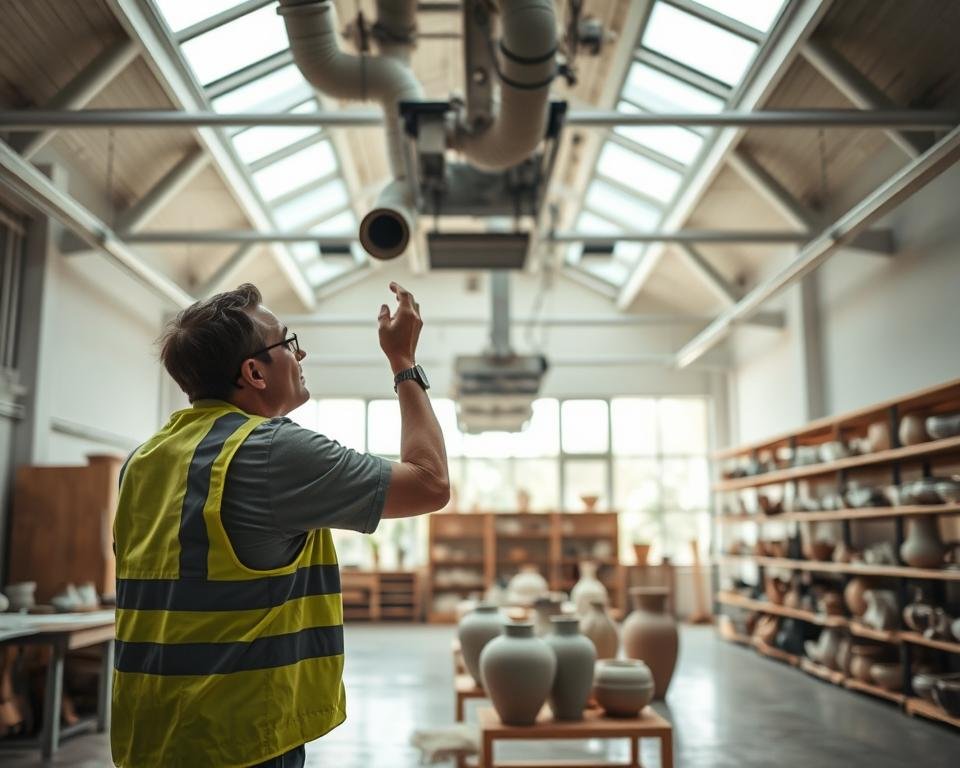As a ceramic artist, you know about the dust and fumes from clay and glazes. But did you know these particles can cause serious health problems? Issues like respiratory problems and even cancer are possible.
Keeping your studio well-ventilated is key. Proper air quality helps remove harmful particles. This makes your workspace safer and healthier. With good ventilation, your studio becomes a place where creativity and productivity thrive.
Key Takeaways
- Understand the risks associated with poor air quality in ceramic studios
- Learn how to assess your studio’s ventilation needs
- Discover simple and effective ways to improve air quality
- Create a healthier and safer workspace for ceramic artists
- Boost creativity and productivity with a well-ventilated studio
Why Ventilation Matters in Ceramics
Ventilation is key to keeping the air clean in ceramics. When we work with clay, glazes, and kilns, particles and fumes get released. Without proper ventilation, these can harm our lungs and health.
A studio with good ventilation is vital for ceramic artists’ health. A strong ceramic kiln ventilation system greatly lowers risks from kiln firing. This is very important when using materials that give off harmful fumes.
Understanding Air Quality
The air quality in a ceramic studio depends on many things. This includes the clay and glazes used, how we fire things, and the studio’s layout. To keep the air clean, we need to know how these things work together. A ceramic dust extraction system can cut down on airborne particles.
The table below shows common air pollution sources in ceramic studios and how to fix them:
| Source of Pollution | Potential Solution |
|---|---|
| Clay and glaze particles | Implement a ceramic dust extraction system |
| Kiln fumes | Install a ceramic kiln ventilation system |
| Studio layout | Optimize studio design for airflow |
Health Risks of Poor Ventilation
Poor ventilation in a ceramic studio can cause serious health problems. This includes breathing issues and lung damage over time. Being exposed to harmful fumes and particles for a long time can lead to other health issues. It’s important to know these risks to stay safe.
By understanding the need for good ventilation, ceramic artists can make their workspaces safer and healthier. Keeping ventilation systems in good shape and following safety rules are key to avoiding health risks.
Types of Ventilation Systems
To keep your ceramic studio safe and healthy, it’s key to look at different ventilation systems. Good ventilation is vital for removing harmful particles and fumes. This makes your workspace safe.
Natural Ventilation Options
Natural ventilation uses the air around your studio. It uses windows, doors, and openings to ventilate. This method is cheap and can work well, if your studio is well-designed.
- Advantages: Energy-efficient, cost-effective, and easy to set up.
- Disadvantages: It depends on the weather, and might not work for big or busy studios.
Mechanical Ventilation Solutions
Mechanical ventilation uses fans and ducts to remove air. It’s a more controlled and reliable way to ventilate. These systems are great for bigger studios or those with lots of kiln use.
- Advantages: Very effective, can be tailored to your studio, and works all the time.
- Disadvantages: Costs more upfront, needs upkeep, and uses energy.
When choosing between natural and mechanical ventilation, think about your studio’s size, layout, and needs. Many studios do best with a mix of both.
Knowing the pottery ventilation requirements and designing a good kiln room ventilation design is key for a safe studio. The right ventilation system keeps you healthy and makes your studio better.
Key Factors for Effective Ventilation
To keep the air clean, you need to think about a few important things when setting up a ventilation system for your ceramic studio. It’s not just about picking any system. You need one that fits your studio’s needs perfectly.
Studio Size and Layout
The size and layout of your studio are key to picking the right ventilation system. A bigger studio needs a stronger system to clear the air. The way your studio is set up, including where your workstations and kilns are, also affects how well air moves.
Michael Jones, a ceramic studio owner, says, “Knowing your studio’s layout is key to a good ventilation system.”
For example, a studio with high ceilings might need a system that moves air up and down well. But a smaller studio might do better with a more compact system.
Material Handling and Dust Control
How you handle materials and control dust is also very important. When working with clay and glazes, it’s vital to keep dust out of the air. Using a dust collector or a wet method for cutting and grinding can help a lot.
“The key to effective ventilation is not just about removing contaminants from the air, but also about preventing them from becoming airborne in the first place.” –
Good dust control not only makes the air cleaner but also keeps you and your workers healthier. By combining smart material handling with a good ventilation system, you can make your studio a better place to work.
To make your studio’s air even better, think about these ideas:
- Check and fix your ventilation system often to keep it working well.
- Use exhaust fans smartly to move air and get rid of bad stuff.
- Look into smart ventilation tech that can adjust airflow based on air quality.
By considering these points and getting a ventilation system made just for your studio, you can have the best ventilation for your ceramic workshop. And you’ll keep your ceramic studio air quality top-notch.
Best Practices for Studio Ventilation
To make your studio’s air better, it’s key to know the best ways. Good ventilation helps get rid of bad air and keeps artists healthy.
Positioning Windows and Doors
Placing windows and doors right can help air flow better. This means you might not need to use fans as much. Here are some tips:
- Open windows and doors on opposite sides to make a cross breeze, which helps air move.
- Choose windows that are higher up to let hot air out, which improves ventilation.
- Think about the wind direction when placing windows and doors for the best airflow.

Using Exhaust Fans Effectively
Exhaust fans are important for removing dust and smells. To use them well:
- Put exhaust fans near where dust and smells come from, like workbenches or kilns.
- Make sure exhaust fans are the right size for your studio. This depends on how much air needs to be moved.
- Keep exhaust fans clean and working right to make sure they do their job.
By following these tips, ceramic artists can make their studios healthier and more productive.
Choosing the Right Ventilation System
Choosing the right ventilation system for your ceramic studio is key to a safe and healthy work space. A good system improves air quality and boosts your productivity.
Start by thinking about what your studio needs. Look at the size of your studio, the ceramic work you do, and your budget. For example, if you use electric kilns, you need a system that removes fumes and particles well. Learn more about venting electric kilns on the Ceramic Arts Network.
Assessing Your Studio’s Needs
First, check your studio’s layout and size. A bigger studio might need a stronger system, while a smaller one might do with something more compact. Think about the materials and processes you use. For instance, if you work with hazardous glazes, you need a system that captures and removes these substances well.
Comparing Ventilation Products
After figuring out what you need, compare different ventilation systems. Look for ones made for ceramic studios and suited for your work. Consider things like airflow, noise, and energy use. Reading reviews and talking to other ceramic artists can also help.
When looking at products, focus on what’s important to you. Some systems have cool features like variable speed controls or remote monitoring. By carefully looking at your options, you can find a system that fits your needs and improves your studio experience.
Maintaining Your Ventilation System
A well-maintained ventilation system is key for ceramic studio artists’ health and safety. Regular upkeep makes sure it keeps the air clean by removing ceramic dust.

Regular Inspection and Cleaning
For your ceramic studio ventilation system to work best, regular checks are a must. Look for dust, damaged ducts, and old filters. Cleaning or swapping out these parts keeps air flowing well.
For example, fresh filters help grab more ceramic dust.
Upgrading Components as Needed
As time goes by, your system might need new parts. This could mean getting better fans or a ceramic dust extraction system for heavy use. Keeping up with new tech boosts your system’s performance.
Focus on upkeep and updates to make your ceramic studio a healthier, more productive place.
Ventilation and Kiln Operation
Running a ceramics studio well means having good ventilation. It’s key to handle the fumes and heat from firing. This keeps the work area safe.
Importance of Exhaust During Firing
Kilns let out harmful fumes like VOCs and particles during firing. A good kiln room ventilation system is vital. It gets rid of these fumes and keeps the air clean.
- Reduces exposure to harmful fumes and particles
- Helps maintain a consistent firing environment
- Enhances overall studio safety
For more info on kiln vents, check out Ceramic Arts Network. They offer great tips on kiln operation and ventilation.
Avoiding Overheating Issues
Overheating can damage kiln equipment and pose safety risks. Good ventilation helps avoid this. It keeps the kiln room cool during firing.
- Ensure adequate airflow around the kiln
- Use exhaust fans to remove excess heat
- Monitor kiln temperature closely during firing
By following these tips and getting a good pottery ventilation system, you can lower overheating risks. This makes your ceramics studio safer and more efficient.
Innovative Ventilation Solutions
Ceramic studios are now using advanced ventilation systems to improve air quality. This helps artists stay healthy and focused. Keeping a studio environment clean is key as the ceramics industry grows.
Smart Ventilation Technologies
Smart ventilation is leading the way in ceramic workshop air quality. These systems use advanced algorithms and real-time data. They make sure air quality stays high, even when studios are busy.
Key Features of Smart Ventilation Systems:
- Real-time air quality monitoring
- Automated adjustment of ventilation rates
- Integration with other studio systems for holistic control
By using smart ventilation, ceramic studios can cut down on air quality risks. This makes the workspace safer and more productive.
Incorporating Sensors for Air Quality
Air quality sensors are key in modern ventilation systems. They watch the studio environment closely, catching even small air quality changes.
The Benefits of Air Quality Sensors:
- Early detection of pollutants and particulate matter
- Enhanced control over ventilation system operation
- Data logging for long-term air quality analysis
With these sensors, studio owners can make sure their ventilation systems work well. This keeps the environment healthy for artists.
Here’s a comparison of traditional ventilation systems versus those with smart technologies and air quality sensors:
| Feature | Traditional Ventilation | Smart Ventilation with Sensors |
|---|---|---|
| Air Quality Monitoring | Manual Checks | Continuous Monitoring |
| Ventilation Control | Manual Adjustment | Automated Adjustment |
| System Integration | Limited | Holistic Control |
As the table shows, smart ventilation systems with sensors have big advantages. They keep air quality better than traditional methods.
Regulatory Standards and Guidelines
Ceramic studios must follow certain rules to keep everyone safe. I’ll help you understand these rules. Following them is not just the law; it’s also key for the health and safety of all in the studio.
OSHA Regulations for Ceramic Studios
The Occupational Safety and Health Administration (OSHA) has rules to protect workers. OSHA says studio owners must keep the workplace safe. This means checking the air quality and making sure there’s enough ventilation to stop harmful dust and fumes.
Some important OSHA rules to remember are:
- Make sure there’s enough air flow to stop harmful particles from building up.
- Use controls to lower the risk of silica dust, a big problem in ceramic studios.
- Give employees PPE when they need it.
Local Building Codes to Consider
Ceramic studios also have to follow local building codes. These codes can change a lot depending on where you are. Local codes might have rules for ventilation, electrical work, and fire safety. It’s important to talk to local authorities to know what rules apply to your studio.
Some things local codes might cover are:
- What kind of ventilation system you need based on your studio’s size and layout.
- Rules for kiln installations, like ventilation and electrical standards.
- How to store and handle dangerous materials.
By following OSHA rules and local codes, you can make your ceramic studio a safer place. This keeps your employees and visitors safe. It also helps make your studio a better place to work and be creative.
Conclusion: Creating a Healthier Workspace
Improving ventilation in your ceramic studio is key for a healthier work area. Knowing how important ventilation is and setting up the right system can greatly lower health risks from bad air.
A good ceramic kiln ventilation system is essential. It removes harmful fumes and particles when firing. This keeps you healthy and improves your ceramics work.
Benefits of Proper Ventilation
Good ventilation brings many benefits. It improves air quality, lowers the chance of breathing problems, and makes your workspace safer. A well-ventilated studio lets you work on your craft without worrying about your health.
Safety and Creativity in Ceramics
Putting ventilation and safety first lets you be your most creative. A safe and healthy place to work encourages new ideas and techniques in ceramics.
